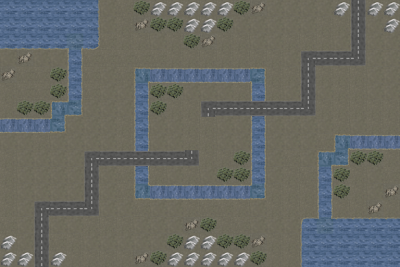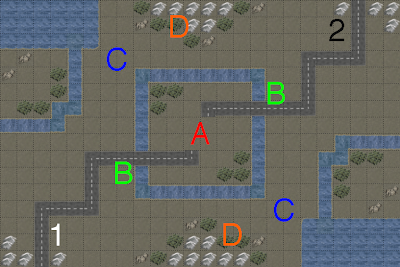As Callum pointed out earlier, the map we're working with for testing is not one you'd want to use when actually playing a game. First of all, it needs to be fair. This usually implies symmetry or randomness (which I will get on to further down), or both. More importantly, however, a good map needs to be interesting.
Consider the map below:

This map looks quite nice: the trees are by the water and the mountain, and everything is spread out in an even way. What really matters about this map, though, is that there are multiple strategies a player is likely to consider:

So, we have Player 1 starting in the bottom left, and Player 2 starting in the top right. Because roads provide such a large bonus to movement, mobilising troops towards the centre of the map (A) is very easy and the fastest path to the enemy. However, the choke points caused by the bridges (B) mean that you can hold off your opponent. The alternative is to go round the sides, passing through (C). Note that because of the very defensive terrain near (D), it would be wiser for Player 1 to attack along the bottom of the map whereas Player 2 would be better off going along the top. This slight imbalance means that you either have to scout or preempt your opponent.
This constitutes what I would call a fairly good map. If you had the added complexity of resources (which we might get around to adding at some point) and construction of units, many resources placed in the centre and perhaps a few along the flanks would make this map more fun.
Our criteria for maps, such that they could be generated via some seed numbers (and perhaps a selection of other factors) would have to be as follows:
-The two teams can reach each other
-Tiles are assembled correctly (i.e. rivers the right way around)
-The map is symmetrical (simply because this makes balancing so much easier)
But what about if we want good maps:
-There is more than one route to the enemy
-There is imbalance in these routes, such that decisions have to be made by each player as to which route to take
-Aesthetic appeal and 'common sense' in placement of tiles (this is a hard, yet interesting bit)
-There is ample space to manoeuvre troops, but also choke points
I am all for a random map generation option: it gives the game a longer lifespan, can be more fun under certain circumstances and provides variety. However, if 10 or 20 maps similar to the above (which was not by any means a challenge to make) could be played to provide this variety, the quality of the random maps would need to be quite good to compete. It looks like if we want to give the game more longevity via maps, letting the user use Tiled to make their own is the best option at this point.
No comments:
Post a Comment